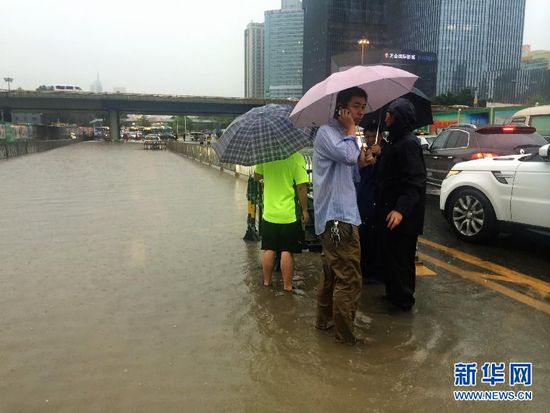Interannual relationship between the winter Aleutian Low and rainfall in the following summer in South China
Date:2015-06-01
The interannual and intraseasonal variations of summer rainfall in South China (SC) are very large, often bringing extreme floods and droughts that can exert significant impacts on agriculture, industry, and the daily lives of people. Hence, achieving a better understanding of the summer rainfall variability in SC as well as its influencing factors and therefore skillfully forecasting the summer rainfall are of great importance for both society and economic development.

Heavy rainfall in Shenzhen, Guangdong province on 23 May 2015 (photo by Xinhua news agency). The averaged rainfall amount was 103.4mm in Shenzhen and the maximum rainfall amount was 196.1mm occured in Longgang District.
Dr. SONG Linye and Prof. DUAN Wansuo from the Institute of Atmospheric Physics investigated the interannual relationship between the winter Aleutian Low (AL) and the rainfall anomalies in the following summer in South China (SC). They found that the winter AL is significantly positively (negatively) correlated with the SC rainfall anomalies in the following July (August), especially after the late 1970s.

Correlation of DJF ALI with (a) July and (b) August rainfall in the following year. Heavy (light) shading in (a, b) indicates correlation coefficients significant at the 95% (90%) confidence level. Contour intervals are 0.1 in (a, b), and the green box is the region of SC (22–30°N, 105–118°E) in this study. Lag-lead correlation of ALI from preceding SON to JJA with (c) July and (d) August rainfall indices obtained from the UD rainfall dataset during 1901–2004. The dashed lines indicate significance at the 95% and 90% confidence level. (e) Sliding correlations between DJF AL index and July SC rainfall index displayed at the central year of a 21-yr window. (f) As in (e) but for the August rainfall index. Horizontal dashed lines in (e, f) indicate the correlation coefficient is significant at the 90% confidence level. Note that all variables have been subjected to a nine-year high-pass filter and the DJF ENSO signal has been linearly removed in constructing this figure. (Figure plotted by IAP)
The winter AL-related atmospheric circulation anomalies in the following summer were also examined. When the winter AL is stronger, there is a significant anticyclonic (cyclonic) circulation anomaly over the subtropical western North Pacific in the following July (August). Southerly (northerly) wind anomalies to the west of this anomalous anticyclonic (cyclonic) circulation increase (decrease) the northward moisture transportation and contribute to the positive (negative) rainfall anomalies over SC in July (August).

Anomalies of (a, d) 1000 hPa geopotential height (units: m), (b, e) 850 hPa horizontal winds (units: m s?1) and (c, f) 500 hPa geopotential height (units: m) in (a–c) July and (d–f) August regressed on the normalized DJF ALI during 1979–2004. Heavy (light) shading indicates geopotential anomalies that are significantly different from zero at the 95% (90%) confidence level. Note that all variables have been subjected to a nine-year high-pass filter and the DJF ENSO signal has been linearly removed in constructing this figure. (Figure plotted by IAP)
Hence, the research results indicate that the AL in the preceding winter can be used as a potential predictor of the rainfall anomalies in the following July and August over SC.
This research has been published in Atmospheric Oceanic Science Letters recently.
Citation: Song, L.-Y., and W.-S. Duan, 2015: Interannual relationship between the winter Aleutian Low and rainfall in the following summer in South China, Atmos. Oceanic Sci. Lett., 8, doi:10.3878/AOSL20150021.
Download: http://159.226.119.58/aosl/EN/abstract/abstract562.shtml
Contact: DUAN Wan-Suo, duanws@lasg.iap.ac.cn
